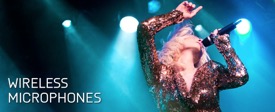Fundamental Flaw of the Docket 14-165/6 4 MHz Wireless Mic Set-Aside:
Giving Free Spectrum for “Licensed Wireless Microphones” to Mostly Rich Corporations That Will Inevitably Be Very Lightly Used

However, certain private entities decided to expand this de jure use with additional de facto use without the benefit of public policy deliberations and such use would appear to have been a criminal violation of §301. Yet the wireless mic industry, their non broadcast customers, and the FCC quietly looked the other way for decades. In Docket 01-75 the FCC described the NPRM as “an extensive review of the BAS rules and propose changes to create a more efficient BAS that can readily adapt to regulatory and technological changes.” The hypocrisy of the wireless mic industry is evident in the filing by Shure, Inc. in Docket 01-75, the only filing by any party interested in non broadcast/non film production use of wireless mics. At the time Shure was routinely marketing wireless mics to noneligible users by implying that they were Part 15 devices that did not need a license. The Shure reply comments state unambiguously in a heading:
![]()
(LPAS = Low Power Auxiliary Stations = Part 74, Subpart H)
The Shure filing goes on to cryptically mention on p. 4
While subtlely acknowledging illegal uses, they never asked that they be normalized and no other wireless mic user or manufacturer spoke at all in the 3 year long proceeding!“numerous activities conducted by businesses, religious and educational institutions, governmental bodies at all levels,law enforcement agencies, musical productions, and theatres (to name but a few). The American public relies heavily upon wireless audio equipment in the course of their daily work, worship, education and entertainment activities.”
In the new twin FCC NPRMs that deal with wireless mics, Dockets 14-165/166 we have the following proposed band plan for the “duplexer gap” between the cellular uplinks and downlinks in the repurposed 600 MHz TV spectrum after the incentive auction.
Note the 4 MHz orange colored block labeled “Licensed wireless microphones”. What is this block? It is restricted to the classic Part 74 eligibles (broadcasters CATV systems, and film producers) plus, as a result of a May 2014 R&O, the “Large venue owners or operators as defined in § 74.801 and Professional sound companies as defined in § 74.801”. The 2 new categories of users both have the requirement of routinely using 50 or more wireless microphones in productions. Note that while these entities have “licenses”, they are paying no apparent fees at all for spectrum access. (Broadcasters both application fees under §1.1104 and pay annual fees under §1.1153, but there do not appear to be any fees at all for wireless mic users in the litany of Part 1, Subpart G fees unlike virtually all commercial users.)
We note that for about 20 years, the general trend has been users of spectrum for commercial purposes pay for spectrum access. So the nonbroadcast wireless mic users are being rewarded for their illegal squatting up until 2010 with guaranteed access to spectrum at no cost at all! Who are these impoverished users? Here are two recent Internet ads from newly eligible users:

Could Lion King and their corporate parents at Disney afford to pay for spectrum use?


But the worst part of the proposal is that it is a return to the “Command & Control” spectrum model of the past that rewards special interests and contributes to the overall low occupancy of US spectrum. When averaged over the entire US and over the entire year, the 4 MHz set aside for “Licensed wireless microphones” will likely be the least utilized nonpublic safety spectrum in the US and may actually be the lowest utilized spectrum even considering public safety. (Public safety spectrum tends to have low utilization due to the bursty unpredictable nature of emergencies and the need to size the spectrum for the worst case incident.)
Yes, in a small section of Manhattan it will be used for a few hours a day. In Central Park and other concert venues it will be used for a few hours a few days of the year. Near some large churches it will be used a few hours a week. But the rest of the time it will be denied to all other users, both licensed and unlicensed. At present wireless mic licensed users have priority access to “vacant” TV channels. The new proposals will make them the sole possible user of 4 MHz, deny that spectrum 24/7 to other users even if there is no wireless mic use within 100 miles, and guarantee the very low utilization of that spectrum 24/7 in 50 states plus territories. Why?
So you ask how would your blogger deal with spectrum for wireless mics? He would have a set aside for wireless mics, but it would be much smaller, it would have a spectrum efficiency standard similar to Part 90, and it would apply to only small wireless mic system users who can not afford the transactions costs of a normal licensed system. Thus eligible users would be wireless mics in office conference rooms, places of worship with modest audio systems, and hotels for DJs and conferences. Perhaps a 10 microphone maximum. For bigger users who need high reliability, they would have to pay for spectrum access either through a variant of the UK system spectrum leasing system managed by Arqiva or through a femtocell-like system provide by cellular operators. For more details on the femtocell-like alternative, see an interview with your blogger in the wireless mic blog RF Venue.
In the UK,all wireless mic users (PMSE in UK jargon) have been paying for spectrum for over a decade. Has it resulted in the “the day the music died”?
This 4 MHz proposal is the worst example of Command & Control spectrum policy since it was discredited in the Spectrum Policy Task Force report in 2002!
UPDATE
For a very different point of view, try this piece from NPR. (Oddly, it also uses Lion King as an example, but doesn’t mention the ticket price. FYI, in London where Disney has to pay for spectrum for wireless mics/PMSE, the cost of seats near the front is £70.75 - £90.00 ($111- $141) so less than in NYC with present “free spectrum”.)
Our recent FCC filing in Docket 14-166 expands on the above discussion.




![Validate my RSS feed [Valid RSS]](valid-rss-rogers.png)

